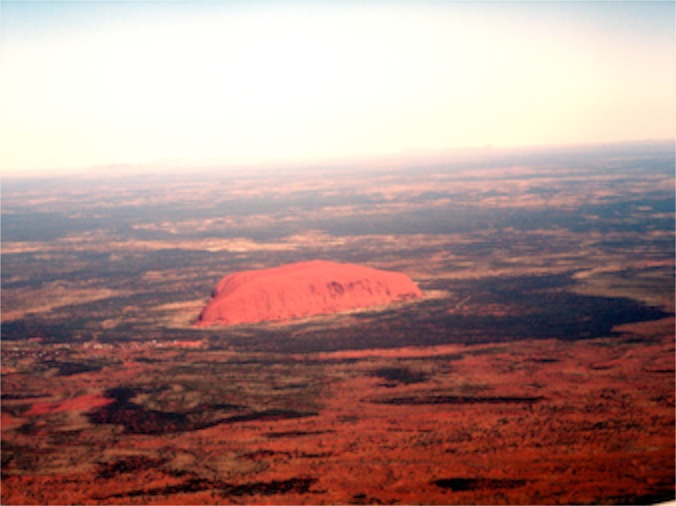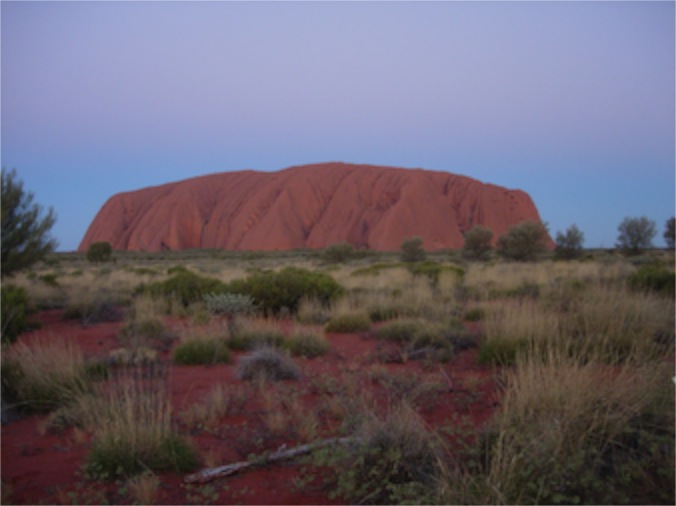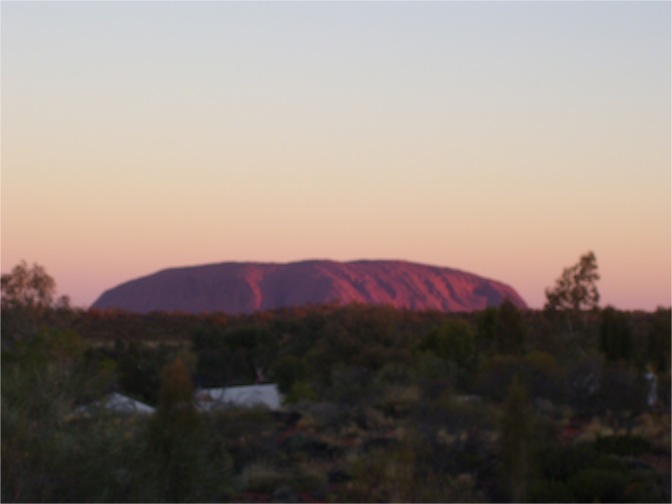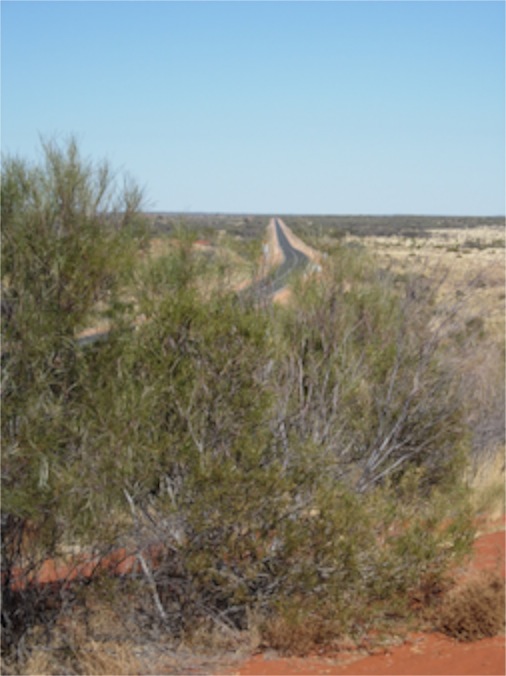The Heartbeat of Australia
24/03/12 05:09
We arrived at Uluru in the center of Australia in the middle of the day. We landed at Uluru airport having flown from Melbourne. My eyes were pinned to the window of the airplane as we flew across such an expanse of empty country. If you were to drive there, it would be over 1,400 miles Even with Australia’s lack of speed limits in the really empty country it would be 26 hours of driving. Flying took a few hours. It is amazing to see so much area with so few signs of habitation. Under the route we took, there were virtually not roads to be seen. As we descended, we got a glimpse of the enormous rock rising from the desert. Words do not describe what we saw.
 After picking up our rental car, figuring out where we would be staying, and catching a bite for lunch we entered Uluru-Kata Tjuta National Park. We spent the afternoon exploring Kata Tjuta, a series of amazing monoliths a short distance from the big rock. Our plan was to hike around Kata Tjuta in the afternoon, where there was plenty of shade. Even though we were visiting in the winter, we were still in the desert. That evening, as the sunset behind us, we watched the display of color on Uluru. The colors reflected by the giant rock ran the spectrum from red to orange to yellow to purple. Just watching the rock in the changing light was entertainment.
After picking up our rental car, figuring out where we would be staying, and catching a bite for lunch we entered Uluru-Kata Tjuta National Park. We spent the afternoon exploring Kata Tjuta, a series of amazing monoliths a short distance from the big rock. Our plan was to hike around Kata Tjuta in the afternoon, where there was plenty of shade. Even though we were visiting in the winter, we were still in the desert. That evening, as the sunset behind us, we watched the display of color on Uluru. The colors reflected by the giant rock ran the spectrum from red to orange to yellow to purple. Just watching the rock in the changing light was entertainment.
 Just as the sun slipped beneath the horizon, when the top of the rock was still lit, but we were in darkness, it began to look as if it were slowly pulsing. I can’t describe it accurately. We knew it was a large rock. We knew it wasn’t moving, but the visual perception is of a slow pulsing in the fading light.
Just as the sun slipped beneath the horizon, when the top of the rock was still lit, but we were in darkness, it began to look as if it were slowly pulsing. I can’t describe it accurately. We knew it was a large rock. We knew it wasn’t moving, but the visual perception is of a slow pulsing in the fading light.
The experience was repeated the next morning after we arose in the dark and climbed to the top of a small hill to watch the sunrise. As the light began to play on the rock we could sense this pulse.
It was as if we could see the heartbeat of Australia.
When you are there, you have no difficulty understanding why this is a sacred site for the people who have lived in the red center of the continent for thousands of years. The Anangu may be the oldest continual culture on the planet. We learned more about them in our visit to the cultural center and our walkabout at the base of the rock the second day of our visit before we drove to Alice Springs for more adventures.
 They say you could feel the earth move at Uluru yesterday.
They say you could feel the earth move at Uluru yesterday.
The 6.1 magnitude earthquake was one of the biggest earthquakes recorded in Australia – the largest in the last 15 years. Actually Uluru was more than 200 km (125 miles) away from the eipcenter.
Ernabella is home to a few hundred Anangu, with more living in the surrounding area. It is, to say the least, remote. If you find Alice Springs near the center of the continent on a map, Ernabella is 317 kilometers (197 miles) southwest of Alice Springs. Heading in the same direction you’d have to go another 415 km (258 miles) to get to another town, Coober Pedy, which itself isn’t exactly what you would call a big city.
At a magnitude of 6.1 and a depth of almost two miles, such an earthquake could cause damage up to 25 or more miles away. It could be felt as far as 315 miles away. Where the epicenter occurred, however, there were no injuries and there was no damage from the temblor. It was in a really, really, REALLY remote part of the country.
Australia is like that. The majority of the people are clustered in a few coastal cities and some farmland that surrounds those cities. The rest of the continent is very sparsely populated with few roads and few towns and lots of empty space between them.
Today we have the joy of once again making a trip to Eagle Butte to deliver some firewood. It is 171 miles and it takes a bit over 2½ hours to make the trip one way. We stop, so it will be about 3 hours from our departure time when we get there. Along the way, we’ll go through Sturgis and Newell and Faith – not exactly the biggest towns, but significant places with services and lots of people who call them home. I like to speak of such a trip as a journey across empty country because the traffic is light and there are plenty of places where the only signs of human activity we see are the highway, the power line and a few fences.
People in the more urban areas of the country have a bit of trouble getting their minds wrapped around the way we live out here. For us, driving 340 miles for a meeting or to deliver a bit of firewood is not big deal. For them, it is hard to figure out why someone would do so much driving for such a reason. I often have commented that having a pastor new to the state drive halfway across the state for a 30-minute interview with the Committee on Ministry and then drive halfway back across the state is a good introduction to our culture. If they are not from around here they will probably comment. Some will even complain. But it is our way of life. We are used to big spaces and lots of driving.
 The way we live is nothing compared to life in Australia’s outback. Most of the people who live at Erdnabella don’t have cars. They have no reason to own them and no money to buy such an expensive item. They live the way people have been living in the outback for as long as anyone can remember. They occasionally see a car or truck that comes from far away. They like some of the supplies that are delivered. Most of the people have seen airplanes the bring supplies to the area as well. But what they know is open space.
The way we live is nothing compared to life in Australia’s outback. Most of the people who live at Erdnabella don’t have cars. They have no reason to own them and no money to buy such an expensive item. They live the way people have been living in the outback for as long as anyone can remember. They occasionally see a car or truck that comes from far away. They like some of the supplies that are delivered. Most of the people have seen airplanes the bring supplies to the area as well. But what they know is open space.
The ground shook there yesterday, but no one was hurt. No damage was done. Life goes on. Sometimes you can see the heartbeat of Australia. Sometimes you can feel it. But you have to be willing to go to the remote places to experience such a bond with the world.


The experience was repeated the next morning after we arose in the dark and climbed to the top of a small hill to watch the sunrise. As the light began to play on the rock we could sense this pulse.
It was as if we could see the heartbeat of Australia.
When you are there, you have no difficulty understanding why this is a sacred site for the people who have lived in the red center of the continent for thousands of years. The Anangu may be the oldest continual culture on the planet. We learned more about them in our visit to the cultural center and our walkabout at the base of the rock the second day of our visit before we drove to Alice Springs for more adventures.

The 6.1 magnitude earthquake was one of the biggest earthquakes recorded in Australia – the largest in the last 15 years. Actually Uluru was more than 200 km (125 miles) away from the eipcenter.
Ernabella is home to a few hundred Anangu, with more living in the surrounding area. It is, to say the least, remote. If you find Alice Springs near the center of the continent on a map, Ernabella is 317 kilometers (197 miles) southwest of Alice Springs. Heading in the same direction you’d have to go another 415 km (258 miles) to get to another town, Coober Pedy, which itself isn’t exactly what you would call a big city.
At a magnitude of 6.1 and a depth of almost two miles, such an earthquake could cause damage up to 25 or more miles away. It could be felt as far as 315 miles away. Where the epicenter occurred, however, there were no injuries and there was no damage from the temblor. It was in a really, really, REALLY remote part of the country.
Australia is like that. The majority of the people are clustered in a few coastal cities and some farmland that surrounds those cities. The rest of the continent is very sparsely populated with few roads and few towns and lots of empty space between them.
Today we have the joy of once again making a trip to Eagle Butte to deliver some firewood. It is 171 miles and it takes a bit over 2½ hours to make the trip one way. We stop, so it will be about 3 hours from our departure time when we get there. Along the way, we’ll go through Sturgis and Newell and Faith – not exactly the biggest towns, but significant places with services and lots of people who call them home. I like to speak of such a trip as a journey across empty country because the traffic is light and there are plenty of places where the only signs of human activity we see are the highway, the power line and a few fences.
People in the more urban areas of the country have a bit of trouble getting their minds wrapped around the way we live out here. For us, driving 340 miles for a meeting or to deliver a bit of firewood is not big deal. For them, it is hard to figure out why someone would do so much driving for such a reason. I often have commented that having a pastor new to the state drive halfway across the state for a 30-minute interview with the Committee on Ministry and then drive halfway back across the state is a good introduction to our culture. If they are not from around here they will probably comment. Some will even complain. But it is our way of life. We are used to big spaces and lots of driving.

The ground shook there yesterday, but no one was hurt. No damage was done. Life goes on. Sometimes you can see the heartbeat of Australia. Sometimes you can feel it. But you have to be willing to go to the remote places to experience such a bond with the world.